Five minutes with... Sam Jansen, StarLeaf CTO
We explore how the video conferencing platform is taking on Zoom and Teams


Video conferencing has undoubtedly been among the greatest winners over the last two years, helping the world stay connected throughout lockdowns and hybrid work policies. To find out more about the technology that powers a video conferencing platform, we spoke with Sam Jansen, CTO of StarLeaf.
Founded in 2008, the Cambridge-based company provides meeting platforms, messaging tools, and collaboration services for organisations across the world, including the NHS. Between the beginning of January and the end of April 2020, StarLeaf's daily call minutes in the UK surged by 947%, with the firm becoming a prominent player almost overnight.
Starleaf didn’t stop there, though, launching the enterprise communications failover service Standby in October 2021, which businesses rely on to manage disruptive events, like outages. We caught up with Jansen to find out more about the technology StarLeaf relies on.
What does your core infrastructure currently look like?
We run our own private cloud, so we're not based on Amazon or Azure, or similar. We're actually buying Dell blade servers and getting them installed into colocation facilities around the world, writing all the code that runs on them ourselves. It's really quite a custom system.
What’s your biggest priority within the business?
I work quite closely with our product team and they always want another feature – if there's another feature that we can sell, it'd be great for customers. I feel like for us in engineering, it's about delivering the right product features on time, while keeping the platform stable and without impacting current customers. So, somehow, it's just always more features.
Which piece of technology would you say is most critical to achieving this?
If I had to call out one, the one I'd pick would be the database technology. PostgreSQL is a really common database technology and it's just rock solid.
Do you have any preferred technology vendors that you especially invest in?
The actual hardware we buy from Dell – they've been a close technology partner to us for really the history of StarLeaf. Beyond that? Not so much – we have very few third-party dependencies in our system.
Get the ITPro daily newsletter
Sign up today and you will receive a free copy of our Future Focus 2025 report - the leading guidance on AI, cybersecurity and other IT challenges as per 700+ senior executives
What’s the biggest IT challenge you’re currently facing?
Changing our focus towards this new thing called Standby. Standby is a bit of a disruptor, I think. It’s a new product, bringing new ideas to the market which is always fun. It’s challenging, however, because when you do that, you're not armed with all the data to make decisions – when you first release a product to market and on day one, you don't have any customers for it. You don't have the data to say: “Well, we definitely want this feature rather than this one.” We're a little bit down that path now, but it's still relatively early days for that piece of the puzzle. We still have a lot to learn about how the market will respond to it.
Which part of your IT estate are you proudest of?
For me, personally, the very first thing I worked on was the video codec and making it error resilient over the internet. We're using a modified version of standard combined H.264. I personally implemented the code for that and then did some research to make it more error resilient, which is what everyone does now, but back in 2009, was quite novel and empowering our video calls. I'm personally quite proud of that.
What’s the next big project you’re planning on undertaking?
It will be evolving the Standby product set. We've got this brilliant stable audio and video calling cloud with brilliant meeting support, and that works really well.
Personally-speaking, are you a Windows, Mac or Linux user?
That's a fun one. So right now I'm on Windows. When I go into our HQ office, I run on a Mac. When I go into our other office in Cambridge, I run on Linux. I have both an iPhone and an Android phone. So I like them all! I like that they've all got their own pros and cons and I spread myself quite thin across all those operating systems.
In the past ten years, what technology has made the biggest impact on the IT industry, and why?
My first answer would be containerisation, which fixed the inefficiencies of virtual machines (VMs). I think that we're seeing a massive swing in global cloud computing around containerisation.
The next [answer] is how computing devices have changed and gotten so much more powerful. When we started StarLeaf, you needed quite a costly device to make a high definition video call like the one we're on today. Mobile phones couldn't do it, that was impossible. Laptops could if you bought a really expensive laptop and desktop to refine.
That has become a commodity now. We can just assume any device we interact with is powerful enough to make an HD video call and that is really what's allowed video to be brought to the masses. That is how Teams and Zoom can be successful. This technological route of Intel, Arm, and all the manufacturing process around it – just bringing cheap, reliable, incredibly fast CPUs that can just do these video codes for us in real time. So that is something that I've seen change over the years and it dramatically affects the product set that we build at StarLeaf and the services that we can offer. Now we can offer a really high quality video to everyone, not just people with expensive computers.
Having only graduated from City University in 2019, Sabina has already demonstrated her abilities as a keen writer and effective journalist. Currently a content writer for Drapers, Sabina spent a number of years writing for ITPro, specialising in networking and telecommunications, as well as charting the efforts of technology companies to improve their inclusion and diversity strategies, a topic close to her heart.
Sabina has also held a number of editorial roles at Harper's Bazaar, Cube Collective, and HighClouds.
-
 Should AI PCs be part of your next hardware refresh?
Should AI PCs be part of your next hardware refresh?AI PCs are fast becoming a business staple and a surefire way to future-proof your business
By Bobby Hellard Published
-
 Westcon-Comstor and Vectra AI launch brace of new channel initiatives
Westcon-Comstor and Vectra AI launch brace of new channel initiativesNews Westcon-Comstor and Vectra AI have announced the launch of two new channel growth initiatives focused on the managed security service provider (MSSP) space and AWS Marketplace.
By Daniel Todd Published
-
 Better together
Better togetherWhitepaper Achieve more with Windows 11 and Surface
By ITPro Published
-
 Transforming the enterprise
Transforming the enterpriseWhitepaper With Intel and CDW
By ITPro Published
-
 The top trends in money remittance
The top trends in money remittanceWhitepaper Tackling the key issues shaping the money remittance industry
By ITPro Published
-
 How Kantar revamped its IT infrastructure after being sold off
How Kantar revamped its IT infrastructure after being sold offCase Study Being acquired by a private equity firm meant Kantar couldn’t rely on its parent company’s infrastructure, and was forced to confront its technical shortcomings
By Rene Millman Published
-
 Deutsche Bank wraps up Postbank IT integration after bug-laden migrations
Deutsche Bank wraps up Postbank IT integration after bug-laden migrationsNews The IT merger is expected to generate annual savings of €300 million by 2025
By Daniel Todd Published
-
 Analyzing the economic benefits of Dell Technologies with VMware Tanzu & Intel
Analyzing the economic benefits of Dell Technologies with VMware Tanzu & IntelWhitepaper ESG economic validation
By ITPro Published
-
 Defra needs £726 million to modernize pervasive legacy IT issues
Defra needs £726 million to modernize pervasive legacy IT issuesNews A significant portion of IT systems are reportedly still in extended support or are fully unsupported
By Ross Kelly Published
-
 Former TSB CIO fined £81,000 for botched IT migration
Former TSB CIO fined £81,000 for botched IT migrationNews It’s the first penalty imposed on an individual involved in the infamous migration project
By Ross Kelly Published